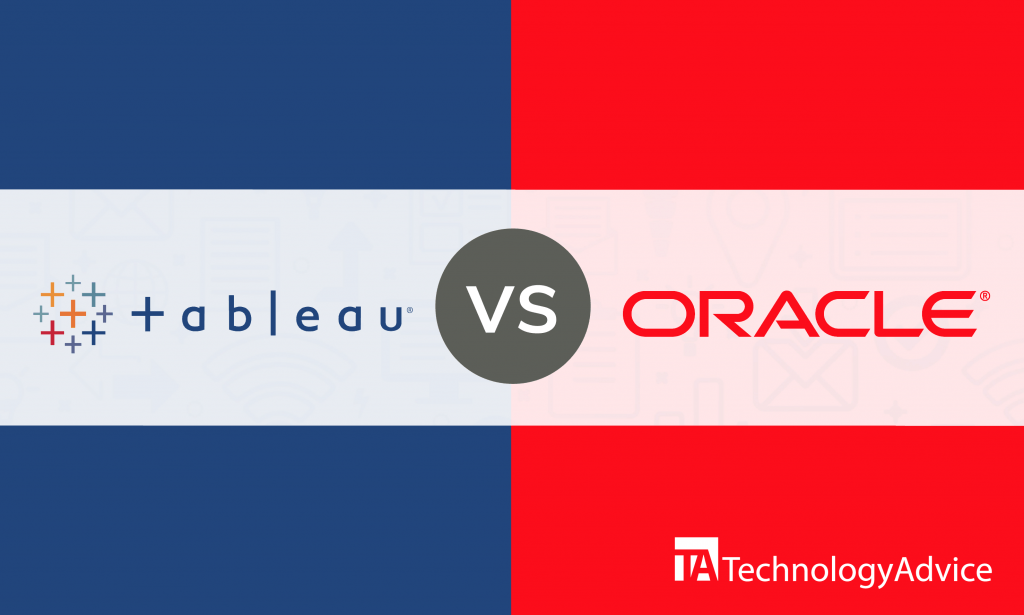- categoryBusiness Intelligence
- ContentComparison
Tableau and Oracle are among the most popular business intelligence (BI) solutions today. Both these BI solutions have significant features, high satisfaction ratings, and powerful capabilities to help companies understand and monitor business performance.
Tableau is a leading BI software that allows businesses to quickly connect, visualize, and share data on various platforms. Oracle is a widely used BI suite that enables companies to create a data-driven culture by utilizing robust visual analytics.
We’ll compare the primary features of Tableau vs. Oracle to help you get a clearer view of the capabilities of each BI software. If you want a free list of up to five recommended BI solutions, use our Product Selection Tool.
An overview of Tableau vs. Oracle
Tableau is an award-winning BI software that helps businesses collect data from multiple source points to create a collective dataset. It aids companies in discovering important business data and making data driven decisions. This software has features for reporting, dashboards, data visualization, data analysis, discovery, management, marketing analytics, predictive analytics, and mobile access. Tableau is best for mid-sized to large businesses and offers high end priced plans.
Oracle is a top BI suite composed of leading technologies and applications designed to provide users with a comprehensive and fully functional enterprise performance management platform. Oracle has features for ad hoc reporting, dashboard, profitability analysis, predictive analytics, servers and storage systems, data warehousing, and mobile access. This BI software was built for large enterprises and has high-end pricing.
Comparing the features
Tableau and Oracle have features for dashboarding, data visualization, and mobile access.
Dashboarding
Tableau lets users build well-designed dashboards that can align an organization’s efforts and help uncover key insights. Tableau dashboards are optimized for phone, tablet, or desktop viewing. Users can choose from several beautiful and informative designs that are tailor-made for key business metrics. With this software, users can also customize the dashboard layout, change its background, group the data, and format its borders. They can also modify the size or position, reorder, and rename individual dashboard items. Tableau dashboards may be published and embedded into a web page.
With Oracle, users can create dashboards to provide personalized views of corporate and external information. The system uses a drag and drop interface to create reports. Users can create a dashboard that displays various views and include prompts on the dashboard to enable users to specify the values to display in these views. Oracle dashboards can be saved privately for a user’s personal use or shared with others. Dashboards in Oracle can also be converted to PDF or HTML format and printed.
Data visualization
Tableau allows users to transform data into an effective visualization or dashboard to help the corporate data make an impact. With this software, users can choose from a variety of built-in charts and graphs such as bar chart, line chart, pie chart, maps, density maps, scatter plot, Gantt chart, bubble chart, and treemaps.
Like Tableau, Oracle also offers a wide selection of charts and graphs for users to be able to represent data more effectively. With Oracle, users can choose from area charts, horizontal bar charts, bubble charts, vertical bars, line graphs, pareto graphs, pie charts, radar charts, and scatter graphs. Some visualizations in Oracle are available in 3D and 2D forms. Styles can also be customized for some of the charts and graphs for this software.
Mobile access
Tableau has native mobile applications for Android and iOS devices. The Tableau mobile app makes it easy to keep a pulse on business data anywhere and anytime. Users get a curated and consistent view of their most important KPIs and view metrics across multiple dashboards directly on their phones. The app comes with interactive previews and works offline as well. Users can select, filter, and drill down with a tap of a finger. The mobile app allows users to interact with data using controls that are automatically optimized for touch. With the app, users get easy access to their favorite and recent dashboards.
Oracle has mobile applications for Android and iOS users, too, called the Oracle Business Intelligence Mobile. With this app, users can view and interact with Oracle BI content and initiate business processes. They can also access, analyze, and take action on their analyses, dashboards, and visualization projects. The app allows users to drill and interact with their reports and apply prompts to filter their data. Users can view interactive formats on geo-spatial visualizations, share server connections, and perform voice queries to view and interact with the BI content. The app offers search suggestions to access the BI content.
Integrations
Integrations for Tableau include tools for sales automation, surveys, web analytics, applicant tracking, and recruitment:
- Salesforce Sales Cloud
- SurveyMonkey
- Google Analytics
- Greenhouse
- Lever
Oracle has pre-built integrations with solutions for eCommerce, customer relationship management, accounting, ordering management system, and analytics:
- Magento
- Salesforce
- NetSuite
- Ordermark
- SAP
Which BI software to choose?
With the capabilities and features of Tableau and Oracle, it’s unsurprising why these BI solutions became top-ranking in the business intelligence industry. In selecting the better suited software for your company, don’t forget to look at the attributes of each software option.
Tableau is the better fit for your business if you want the BI software that can easily be implemented and quickly learned. Tableau has a user-friendly and intuitive interface that makes it ideal for both new and skilled users. Oracle is a comprehensive BI software that can become overwhelming for beginners. However, Oracle offers a complete suite of BI applications that can be suitable for you if you want a software with all-inclusive BI capabilities.
There are numerous software vendors you can depend on for your BI needs. Use our Product Selection Tool to learn more about them.
